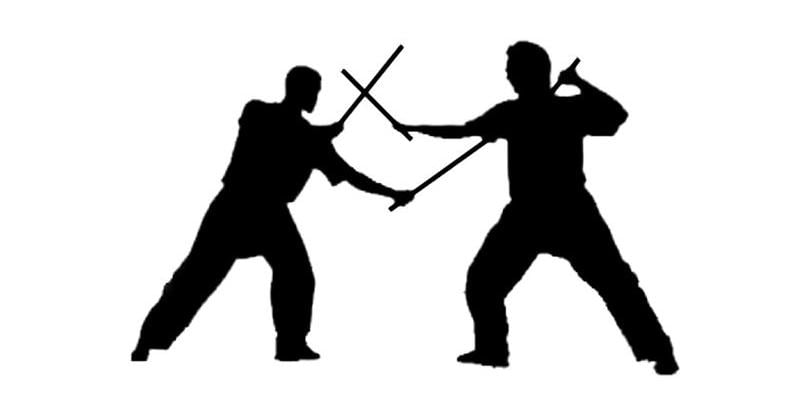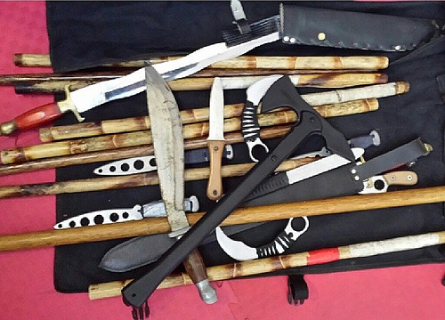Martial Arts Near Me Martial Arts Near Milton Fl
While Traditional Filipino Martial Arts are generally known for Filipino Stick Fighting, it is an fine art the encompasses a diversity of other fighting arts. FMA can be traced back to the 1500s and it has produced a number of world-renowned martial arts since then.
In this section, nosotros will discuss some of the lists of Filipino martial arts our ancestors expert throughout the decades.
Traditional Filipino Martial Arts of Arnis, Kali, and Eskrima
Arnis, Kali, and Eskrima are most popular umbrella terms for the traditional, weapon-based, martial arts of Filipinos. Arnis is a term from the n, Ekrima comes from the central part of the state, and Kali comes from the South.
Numerous practitioners believe that Filipino Martial Arts Kali is the older, more inclusive "warrior's art" than Arnis or Eskrima.

Strike Fast and Powerful Like an Eskrima Grandmaster!
5 Notable Arnis Grandmasters (from the Philippines) teach the secrets to fast and powerful striking. Click Here to Start Training
In general, the terms refer to the Filipinos' indigenous weapon fighting systems. Every group and frequently every Yard Primary accept a distinctive style or technique, but all of them share the same fighting principles and styles. The inherent need for self-preservation was the foundation of these systems.
And all through the ages, local conflicts and foreign invaders imposed new combat dynamics in the islands, now comprising the Philippines. Filipinos developed and enhanced these combat skills mainly because of their e'er-evolving circumstances.
Oftentimes, they learned out of the need to classify, prioritize, and utilize common, day-to-day resource in combative scenarios.
Dissimilar Categories of Weapons in Traditional Filipino Martial Arts
The categories of weapons include bear upon, edged, projectile, and flexible. And there are a variety of weapons taught in FMA, simply the system mainly focuses on the knife and stick fighting. The grooming in empty hand includes grappling and striking.

Traditionally, Kali students begin grooming with weapons and only go on to empty-hands training when the knife and stick techniques take been mastered. This contrasts with many other pop Asian martial arts. The reason in that location may exist to status the trainee to fight against armed attackers because armed fights are very common in the country.
Also, an armed individual evidently has more advantages that the untrained or unarmed assailants.
The concept here is that empty-hand movements are learned naturally through the aforementioned exercises or drills as the weapon styles, making musculus memory a crucial aspect of training. Well-nigh martial arts techniques employ one gear up of methods for the empty hands, stick, and knife, which is a principle commonly called as motility grouping.
The Weapon is Considered Merely as an Extension of the Body in Traditional Filipino Martial Arts
Because the weapon is considered an extension of the practitioner's body, the same footwork and angles are applied either with or with no weapon. The main reason for this has something to do with history. Tribal warriors were constantly engaged in battles using weapons and depended on empty-hand combat simply after losing the weapons.
Numerous systems started grooming with ii weapons, either a stick, a pair of sticks or a knife to enhance their ability to utilise both hands equally; a crucial skill when working with a single weapon. A distinctive feature and core concept of traditional Filipino Martial Arts is the "live hand."
And then even when a student only uses one weapon, the other hand is used to disarm, control, or tap an attacker'due south weapon, every bit well every bit to aid in joint locking, blocking, and manipulation, or other simultaneous moves like destroying the limb using the alive hand.

Kali is oft considered to take these 12 fields of study:
- Single Stick (long bract)
- Double long weapon
- Long and Brusque (sword and dagger)
- Single dagger
- Double Dagger
- Double-stop Dagger or Palm Stick
- Empty Hands (grappling, boot, punching)
- Staff or Spear, long weapons (2-handed)
- Flexible weapons (whip, sarong)
- Projectile weapons (blowguns, bows)
- Throwing weapons
- Healing and Meditation
A distinctive characteristic of FMA is the use of geometry. In defenses, strikes, and movement, angles and lines are imperative. Too, using the easily or both hands and feet independently to perform ii different techniques simultaneously is an advanced skill that is proficient.
Filipino styles and techniques usually classify attacks not just past their weapon or delivery, just past its free energy management, such as in the different angles of attack. Students chief how to handle the attack's energy, then utilize that knowledge to the different variations that come with various lengths and weapons.
Filipino martial arts place a significant emphasis on body positioning, mobility, and footwork. The aforementioned concepts (deflections, passes, traps, angles of attack, etc.) are used in similar cases at various ranges, thus learning and understanding ranges are very crucial.
Filipinos make a wide-ranging use of geometric shapes and applying them to many dangerous situations.
Terminal Words
Those are just some of the traditional Filipino Martial Arts schools that you can observe in the Philippines. The nigh popular among these has always been Eskrima – the Filipino art of Stick Fighting. It is best to choose a school that would suit your needs. In my case, I've chosen the mode of Balintawak Arnis considering of information technology's combative and defensive nature.
Set to Acquire the Fundamentals of Eskrima?
Download this Free Book that teaches you the Essential Training Methods of Eskrima – Essentials of Kali Martial Arts
Read More:
- Arnis Martial Arts – The Warrior's Manner
- Stick Fighting Methods – A Comprehensive Guide
- Arnis Fighting Techniques – A Detailed Guide
Source: https://stickfightingsport.com/traditional-filipino-martial-arts/
0 Response to "Martial Arts Near Me Martial Arts Near Milton Fl"
Post a Comment